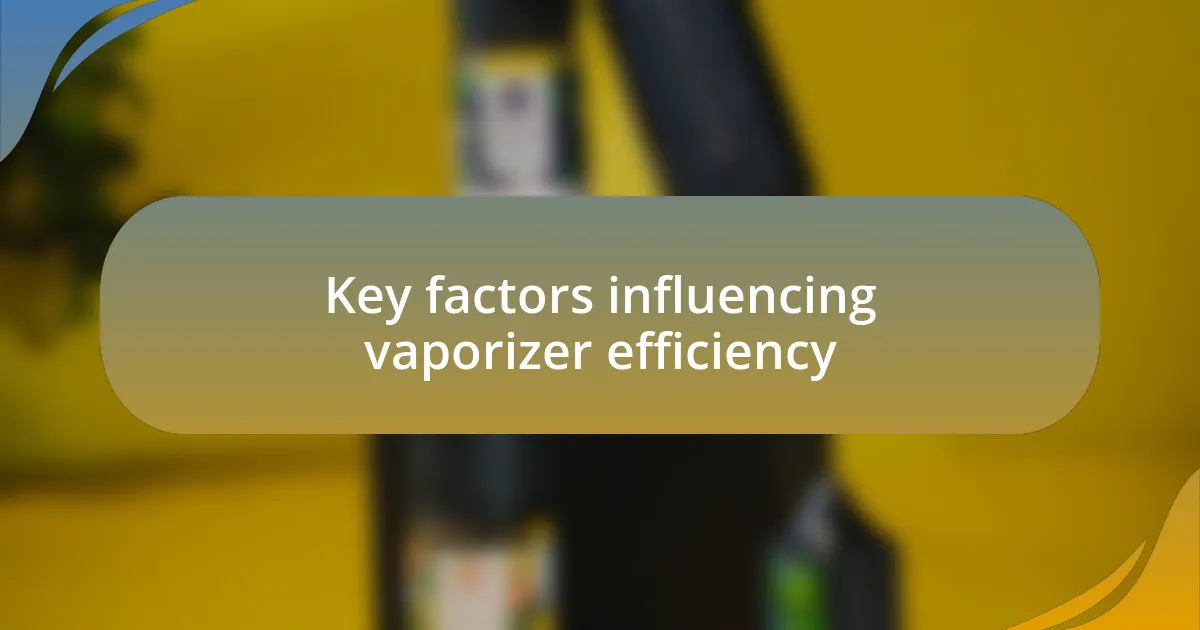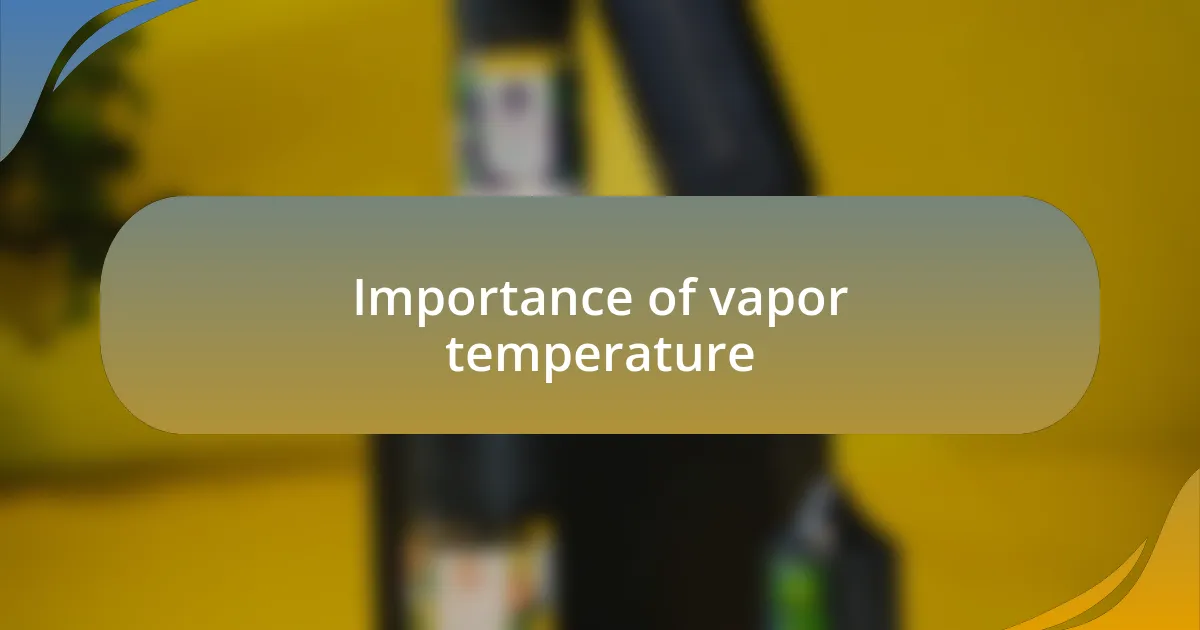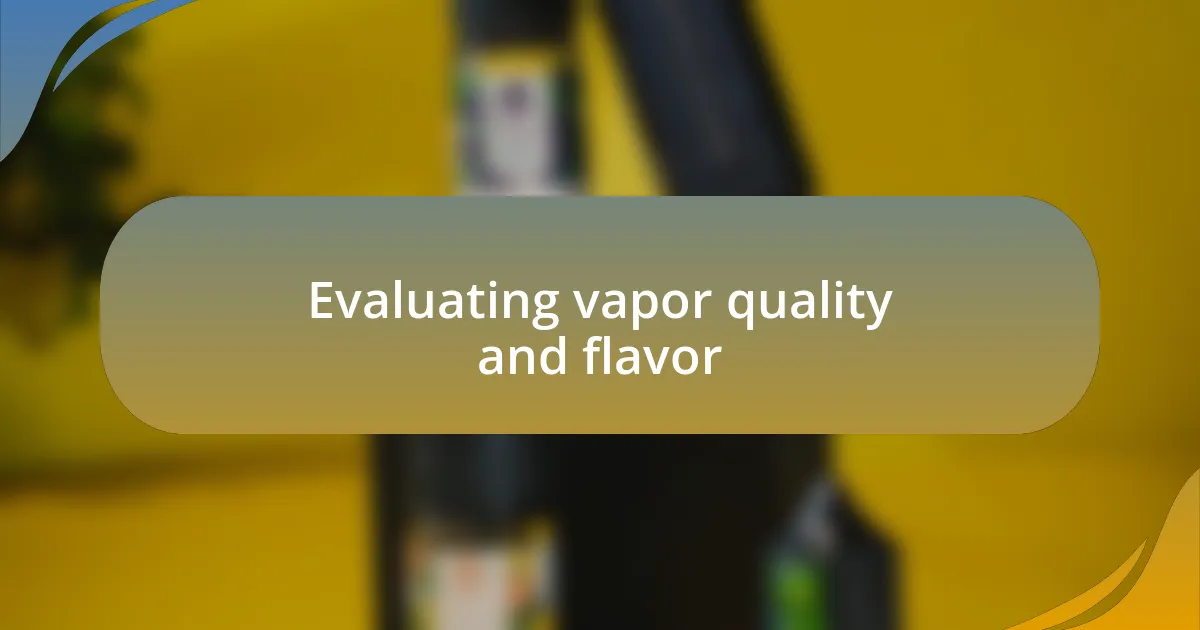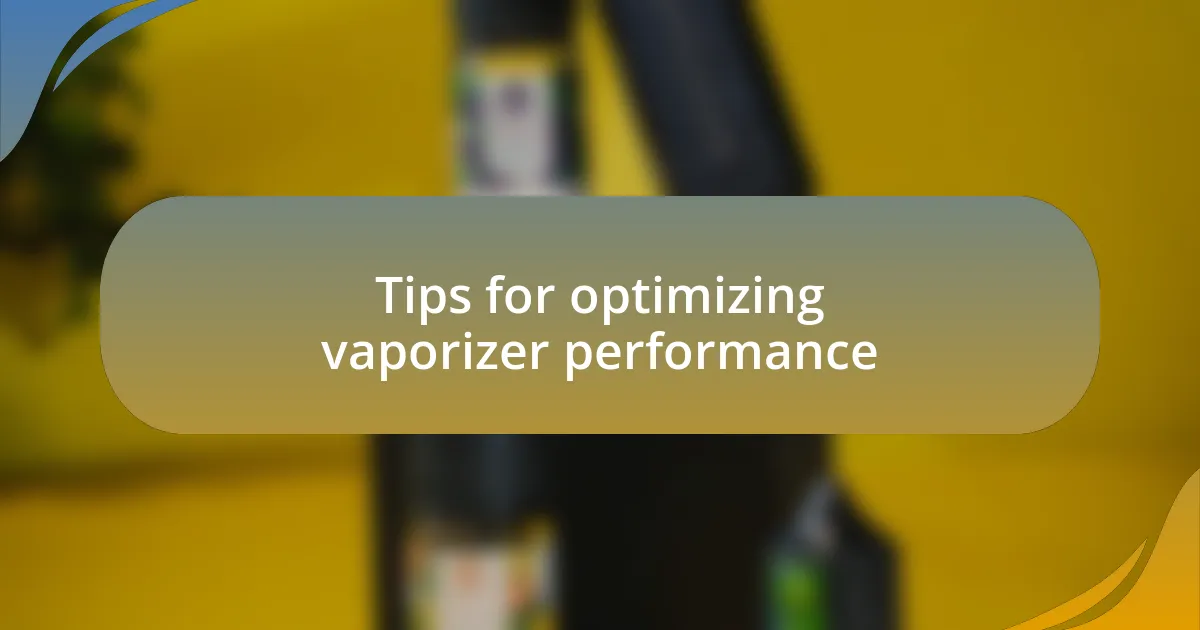Key takeaways:
- Vaporizer performance is influenced by heating methods (conduction vs. convection), temperature control, and the quality of materials used.
- Understanding vapor temperature can enhance flavor and potency, with optimal ranges typically between 365°F to 380°F.
- Regular maintenance, such as cleaning, and experimenting with temperature and grind size can significantly improve the vaping experience.

Introduction to vaporizer performance
Understanding vaporizer performance is essential for anyone looking to enhance their vaping experience. When I first started exploring vaporizers, I found myself overwhelmed by the variety of features and specs that all seemed to promise the same quality. But what truly sets one vaporizer apart from another?
For me, it’s about more than just the technical specifications; it’s about how a vaporizer feels in hand and how it performs under different conditions. Think about your last vaping session: Did the flavor linger? Was the vapor production satisfying? These aspects significantly contribute to overall performance but can easily be overlooked in the excitement of purchasing a new device.
Moreover, the interaction between temperature settings and the material used can dramatically affect your experience. During my trials, I discovered that not every vaporizer excels at the same temperatures, which can lead to different flavor profiles and overall satisfaction. So, how do we measure this performance accurately? It’s all about understanding these subtleties to extract the most from your device.

Key factors influencing vaporizer efficiency
One of the primary factors influencing vaporizer efficiency is the heating method used. Personally, I have experienced both conduction and convection vaporizers, and each has its own unique qualities. While conduction tends to heat the material directly and offers quick results, convection provides a more even and flavorful experience by heating air that passes through the material. This difference can be pivotal—have you ever noticed how a full, robust flavor can transform your vaping experience?
Temperature control also plays a crucial role in vaporizer performance. I’ve often found that dialing in the right temperature can feel like a delicate art. For instance, when I vaporized at lower temperatures, the flavors shone brilliantly, but I noticed a lighter vapor cloud. In contrast, cranking it up created that satisfying dense vapor but sometimes at the expense of the flavor’s subtleties. Have you ever experimented with temperature settings to tease out different flavors?
Another vital aspect is the quality and type of the herbs or concentrates being used. I’ve made the mistake of underestimating the importance of starting with top-notch materials. High-quality herbs provide richer flavors and more potent effects, markedly improving the overall experience. I often think about how much the right strain can elevate a session, creating moments that linger well beyond the last puff. Have you reflected on whether your choice of material is elevating or diminishing your vaping moments?

Importance of vapor temperature
Vapor temperature is essential in determining not just the efficiency of a vaporizer but also the overall enjoyment of the experience. I remember the first time I experimented with higher temperatures; the vapor was dense and warm, but it felt almost overwhelming. It made me wonder—can too much heat overshadow the delicate nuances of flavor? Lower temperatures, on the other hand, sometimes left me craving that satisfying richness, highlighting the intricate notes of my herbs.
When I think back to my first real sessions with temperature control, I recall how I felt like a culinary artist, painting with every adjustment. It was fascinating to discover that specific temperature ranges could unlock different flavors and effects. For instance, certain terpenes, which give flavors and aromas to the herbs, vaporize at lower temperatures. So, have you played around with settings to discover what each temperature brings to your session?
Understanding vapor temperature can profoundly impact not just flavor but also the potency of the vapor. I’ve often found that when I hover in that sweet spot—around 365°F to 380°F—I get a rich, full flavor without sacrificing the desired effects. It’s as if each puff tells a story about the strain. Have you considered how the right temperature can turn your sessions into deeper, more satisfying experiences, helping you connect with your materials on a whole new level?

Evaluating vapor quality and flavor
When evaluating vapor quality, flavor plays a pivotal role. I remember a session where I used a vaporizer that blew me away with its ability to capture the subtle floral notes of my favorite strain. The richness of flavor was so pronounced that each puff felt like I was tasting something genuinely special, almost like sipping a fine wine. It made me realize that there’s a world of difference among vaporizers in how they express these intricate flavors—have you ever noticed that distinct variations?
The material quality and vapor production are equally crucial. During one experiment, I tested a ceramic heating element, and it truly elevated my vaping experience. The vapor was smooth and clean, allowing those delicate flavor profiles to shine through without any burnt taste sneaking in. I often wonder, do you prioritize these aspects when choosing a vaporizer, or are you more focused on design and portability?
Ultimately, the balance between vapor quality and flavor defines our enjoyment. I’ve learned that when the vapor feels thick yet luxurious, it elevates the entire experience. Remember that time you took a long, satisfying draw, and the flavor lingered beautifully? It’s those moments that remind me of the essence of vaping—making the right choices can transform your session into a memorable journey. What flavors do you cherish most in your vaping adventures?

Personal criteria for performance assessment
When assessing vaporizer performance, I can’t overlook how responsive the device is to my sessions. I remember using a portable vaporizer that took mere seconds to heat up, which turned impromptu vaping into a straightforward delight. Have you ever found yourself impatiently waiting for a device to reach the right temperature? That frustration can definitely color the experience.
Something else I consider is the draw resistance. I once encountered a unit where the airflow was frustratingly tight, making each puff feel laborious. In contrast, a well-designed vaporizer should feel effortless, allowing smooth, voluminous draws that enhance flavor without making me work for it. What’s your experience with draw resistance—do you find it affects your enjoyment as much as I do?
Durability is also a key factor for me. I’ve had my fair share of vaporizers that seemed robust at first but crumbled under regular use. One model, however, has survived drops and bumps, and I can’t help but feel a sense of trust in its construction. When a device feels solid, it makes every session more enjoyable—have you ever preferred a vaporizer simply because it felt like it could withstand the test of time?

Tips for optimizing vaporizer performance
One of the most effective ways to optimize vaporizer performance is to maintain the device regularly. I recall a time when I neglected cleaning my vaporizer and noticed a decline in flavor quality. The buildup of residue can really impact the vapor, so setting aside a few minutes after each use for a quick tidy-up not only keeps things tasting fresh but also enhances the overall experience. Have you made cleaning a habit in your routine?
Another essential tip is to experiment with temperature settings. I’ve found that different materials vaporize best at specific temperatures. For instance, I often enjoy my dry herb at around 375°F for a balance of flavor and vapor density. What’s fascinating is that even a slight adjustment can completely change the character of the vapor—have you found a sweet spot that resonates with your preferences?
Finally, the type and grind of the material you use can significantly impact performance. I’ve learned that a fine grind can provide more surface area for vaporization, but it also clogs screens if not monitored. I remember switching to a coarser grind on a recommendation and was pleasantly surprised by the airy quality of the vapor. Have you experimented with different grinds to see how they affect your sessions?